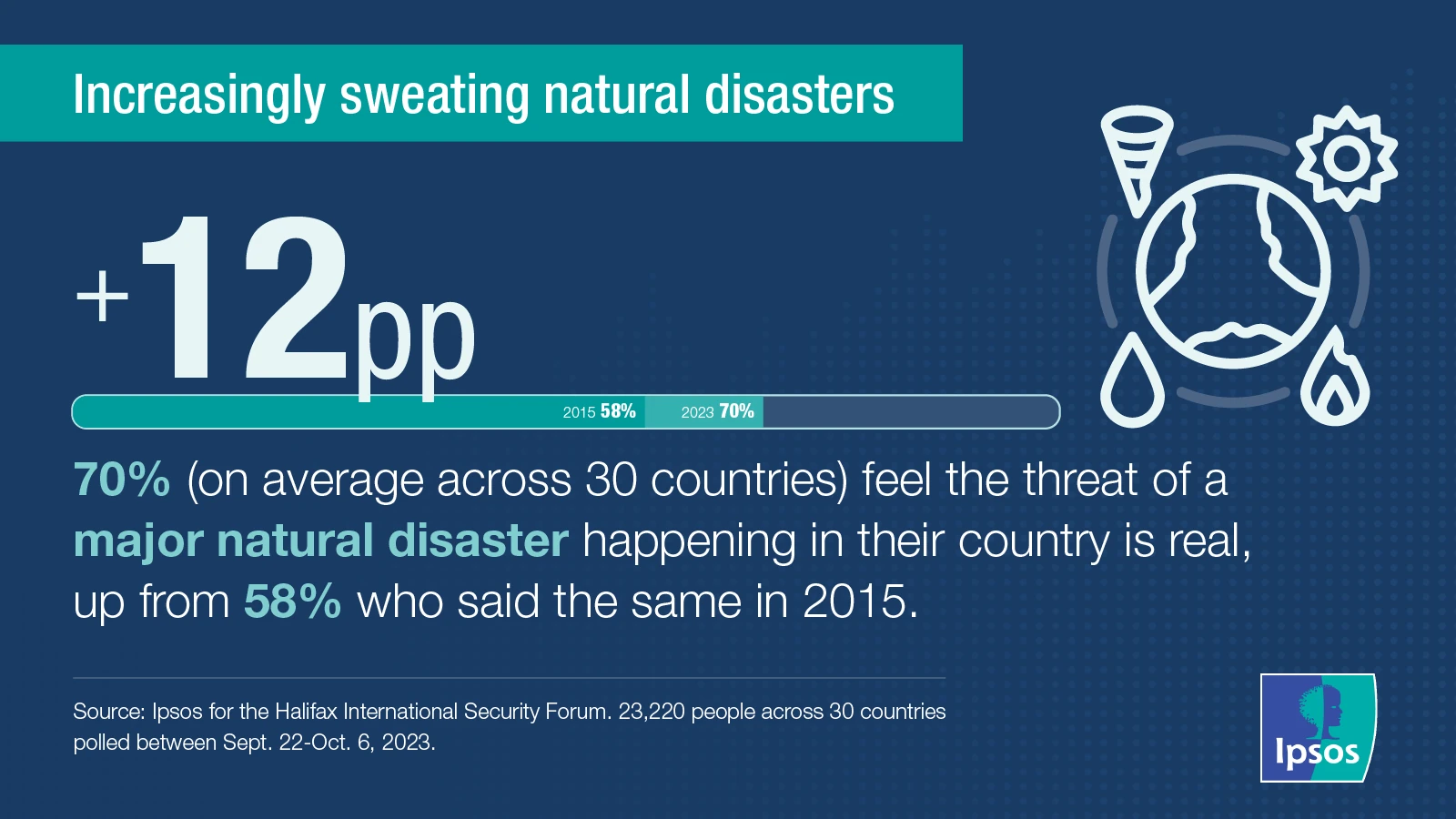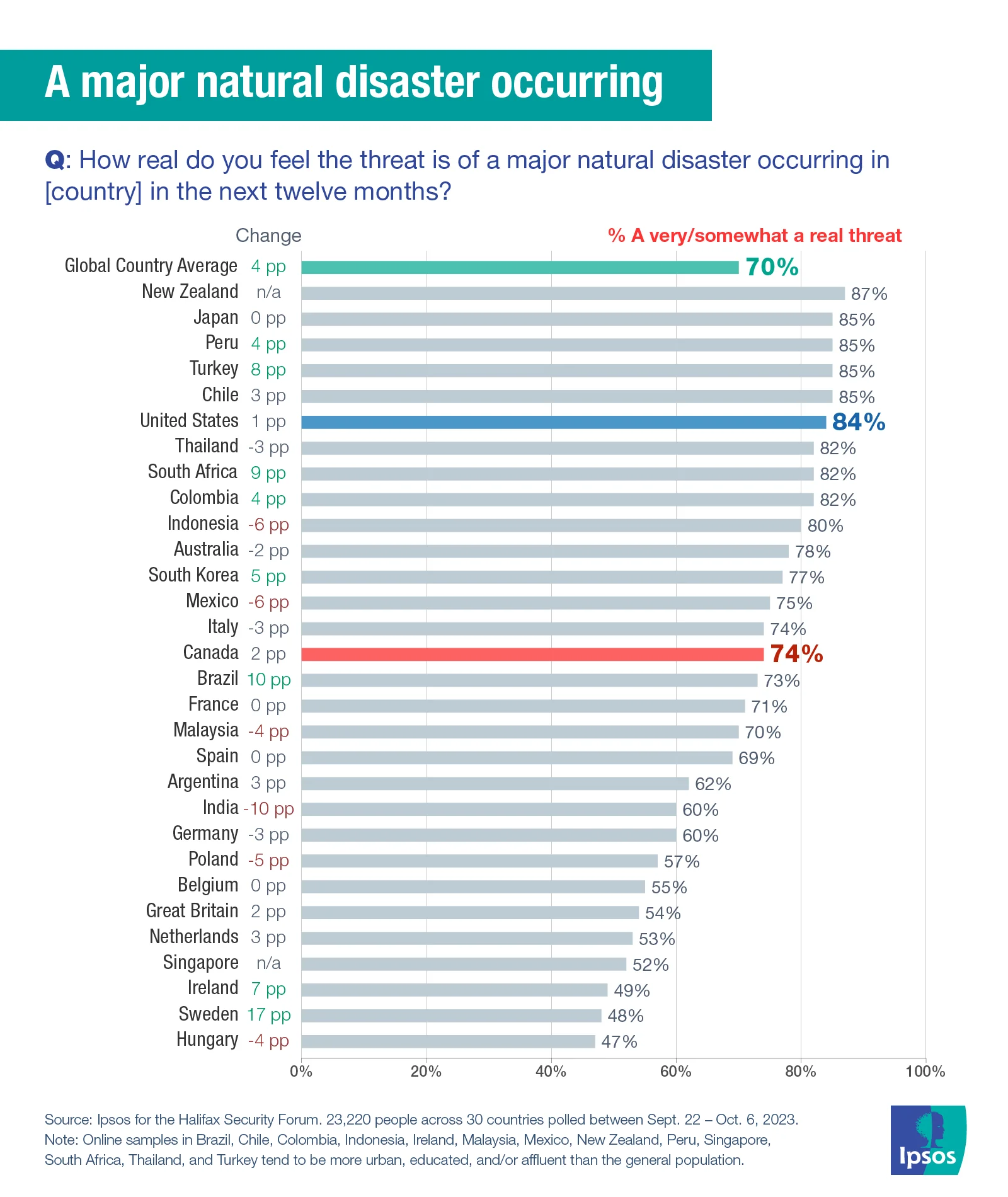HISF-Ipsos Threat Index finds natural disasters seen as fastest-growing threat
After yet another year filled with record-breaking heat, forest fires and floods people around the world are clearly concerned.
A new Ipsos poll of more than 23,000 people – the HISF-Ipsos Threat Index – conducted by Ipsos for the Halifax International Security Forum finds the proportion who feel a major natural disaster taking place in their country is a somewhat/very real threat rose to a global country average of 70% in 2023, up from 66% in 2022 and 58% in 2015.
Given the sweltering summer filled with fires and flooding in the Northern Hemisphere, the proportion of people in Canada (+two percentage points to 74%) and the U.S. (+one pp to 84%) who feel a natural disaster is a threat has risen slightly year-over-year, and concern outpaces the global country average.

Worry about natural disasters looms over other serious threats
This year’s polling was conducted on Ipsos’ Global Advisor online platform between Sept. 22 and Oct. 6, 2023, and thus didn’t capture the impact of the Israel-Hamas war, which began on Oct. 7, 2023, on global sentiment. But our polling did capture how people are feeling on the heels of record-smashing temperatures and as the second year of the invasion of Ukraine drags on.

Natural disasters (70%, +four pts) are currently perceived as a real threat, ahead of a major health epidemic (63%, +three pts), a terrorist attack (63%, +two pts), the personal safety/security of individuals/their family members being violated (63%, +two pts), a violent conflict breaking out between ethnic/minority groups in their country (60%, +one pt) or armed conflict with another country (49%, -one pt). Across most metrics, perceived threats are increasing.
Nuclear/biological/chemical attack concern eases
Concern about a nuclear, biological, or chemical attack happening somewhere in the world surged in the wake of the invasion of Ukraine in early 2022, but has since dropped (71%, -four pts) in 2023.
Despite the dip, concern about a possible attack is still widespread and seen as a real threat by majorities in every country surveyed, ranging from 58% (-five pts) in France to 85% (+one pt) in Thailand.
Countries showing the largest decreases from last year in concern about a nuclear, biological, or chemical attack are Poland (-11 pts to 61%), India[1] (-eight to 64%), Mexico (-seven pts to 71%) and Italy (-seven pts to 58%). Concern fell four points to 69% among Canadians but rose one point to 78% in the U.S where the perceived threat remains much higher compared to the global country average.
Threat of hacking returns to top spot
Cyberhacking is once again considered the No. 1 real threat after being overtaken by fears of a nuclear attack in 2022. Hacking has remained a leading concern for years and stayed put at 74% year-over-year.
Since 2015, hacking for fraudulent or espionage purposes has been seen as the threat most widely found to be real except for in 2020 (the year the COVID-19 pandemic was declared) and 2022 (the year Russia invaded Ukraine).
The proportion of citizens listing cyberattacks as a real threat declined five points or more in four of the 30 countries Ipsos conducted polling in this year, including Australia (-five pts to 79%), Spain (-five pts to 74%), Italy (-five pts to 64%) and India (-nine pts to 63%).
Hacking is considered a real threat for most respondents in all of the countries Ipsos conducted polling this year, but there are significant rises in only three countries — Argentina (+five pts to 75%), the Netherlands (+six pts to 70%) and Hungary (+six pts to 56%). Concern about hacking dropped two points to 79% in the U.S. and rose two points to 77% in Canada.
World a bit worse than it used to be?
Despite people around the world being pummeled by a pandemic, war and inflation in the past few years there hasn’t been a drop off in the proportion who think things are getting better.
The proportion of people who think more things are getting better these days than are getting worse didn’t change year-over-year staying at 47% in 2023 but remains four percentage points lower than in 2017 when Ipsos first started asking this question.
Concern about an epidemic rises slightly
The World Health Organization finally declared an end to the COVID-19 global public health emergency on May 5, 2023, but the virus is still raging in many places.
Hope that the COVID-19 outbreak has been contained and will soon be over dropped slightly to 61% (-one pt) in 2023. Belief that the end of the coronavirus crisis is nigh rose significantly in nine countries, including the Netherlands (+25 pts to 70%), Poland (+16 pts to 70%), Germany (+nine pts to 55%), Thailand (+eight pts to 81%), Sweden (+seven to 59%), Italy (+six pts to 66%), Chile (+five pts to 73%), Australia (+five to 56%) and Belgium (+five to 51%).
While people in seven countries were significantly more pessimistic the COVID-19 crisis has been contained and will end soon, including in Peru (-13 pts to 62%), Turkey (-10 to 57%), Mexico (-seven to 59%), Spain (-seven pts to 58%), Argentina (-seven pts to 57%), Malaysia (-five pts to 68%) and Japan (-five pts to 35%). Hope that the end is near dropped two points in Canada and the U.S. and now sits at 46% in both countries.
The once-in-a-century event unsurprisingly looks to have made an impact on the world’s psyche.
The proportion of people worried about a major health epidemic breaking out in their country rose three percentage points year over year to a global average of 63% in 2023. While that’s well below the 78% who considered an epidemic a real threat in 2020 during year one of the pandemic it’s well above the 51% who thought the same in 2019 pre-pandemic.
Lack of confidence in government and its agencies to deal with threats
Throughout the world, many citizens continue to be skeptical that “the appropriate levels of security and protection could be provided by [their] government or its agencies could respond effectively” to perceived real threats.
In 2023, 63% globally on average view an epidemic breaking out as a real threat, yet only 51% express confidence in their government’s ability to respond if a major health epidemic breaks out in their country — a difference of 12 percentage points. In comparison, 60% of people on average globally felt a major health epidemic breaking out was a real threat in 2022 while the proportion who were confident their government could respond effectively was 51% (a gap of nine percentage points).
And while the majority (a global country average of 70%) feel a natural disaster is a real threat, just over half (53%) remain somewhat/very confident their government could respond to the threat effectively — a gap of 17 percentage points. That’s in comparison to 2022 when 66% viewed a natural disaster as a real threat and 52% were confident in their government’s response — a difference of 14 percentage points.
Table of content
- Canada, Germany most likely to be viewed as positive leaders on world stage
- Attack of the drones: six in ten perceive threat from ai-based defense systems
- HISF-Ipsos Threat Index finds natural disasters seen as fastest-growing threat
- Global citizens achieve near consensus: The world is becoming more dangerous
| Previous | Next |
About this study
These are the results of a 30-country survey conducted by Ipsos on its Global Advisor online platform and, in India, on its IndiaBus platform, between Friday, September 22 and Friday, October 6, 2023. For this survey, Ipsos interviewed a total of 23,220 adults aged 18 years and older in India, 18-74 in Canada, Republic of Ireland, Malaysia, New Zealand, South Africa, Turkey, and the United States, 20-74 in Thailand, 21-74 in Indonesia and Singapore, and 16-74 in all other countries.
[1] Thanks to a change in methodology, the survey now captures the sentiment of a much broader swath of the Indian population. India’s sample now represents a large subset of its urban population — social economic classes A, B and C in metros and tier 1-3 town classes across all four zones.




